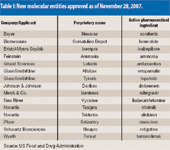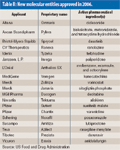2007 Ends with a Drought in New Molecular Entities
PTSM: Pharmaceutical Technology Sourcing and Management
The number of new molecular entities approved by the US Food and Drug Administration is down this year as the pharmaeutical industry continues to face an innovation drought.
As 2007 comes to a close, one of the important measures of pharmaceutical industry growth, the number of approved new molecular entities (NMEs), is down from last year as Big Pharma continues to have difficulties in bringing new drugs to market.

Table I: New molecular entities approved as of November 28, 2007.
Number of NMEs down
The approved 15 new drug applications (NDAs) for NMEs as of the end of November 2007 (see Table 1) and one new biologics application (BLA). This number is down from 2006 totals when FDA approved 22 new products (18 NDAs for NMES and four BLAs) (see Table II).

Table II: New molecular entities approved in 2006.
Ten of the 15 approved NMEs came from Big Pharma, which was on par with NME approvals from Big Pharma in 2006. In 2007, NMEs from Big Pharma were:
- "Ixempra" (ixabepilone) by (New York, NY)
- "Altabax" (retapamulin) and "Tykerb" (lapatinib) by (London)
In 2007, Novartis and and GlaxoSmithline were the only two companies with more than one approved NME. Each company had two. GlaxoSmithKline received approval for its anticancer drug Tykerb and an antibacterial oinment Altabax. Novartis received approval for its hypertensive drug Tekturna and its anticancer drug Tasigna. In 2006, Pfizer and Merck & Co. were the only companies among the top 50 pharmaceutical companies with more than one approved NME. Pfizer had two NMEs approved in 2006: the anticancer drug "Sutent," (sunitinib) and the smoking-cessation drug "Chantix" (varenicline). Merck & Co. received approval for "Zolinza" (vorinostat) to treat cutaneous T-cell lymphoma and for its diabetes drug "Januvia" (sitagliptin). Schering AG (which was acquired by Bayer in 2006), Novartis, and GlaxoSmithKline were among the major companies that also had NMEs approved in 2006. And Amgen, Genentech, and Genzyme were top companies that received BLA approvals for NMEs in 2006. These biologics were:
As of the end of November 2007, only one new BLA was approved: "Soliris" (eculizumab) by (Cheshire, RI).
This month, several FDA advisory committees will meet to consider other NDAs for NMEs. These include tetrabenazine by (Washington DC), vernakalant by (Tokyo), and tedisamil by (Brussels).
Problems with products
In addition to the slowdown in NMEs, several major pharmaceutical companies were plagued with safety issues and concerns for key products in 2007. Perhaps most noteworthy were safety concerns regarding GlaxoSmithKline's antidiabetes drug "Avandia" (rosiglitazone). Sales of the Avandia product group in 2006 were £1.6 billion (3.3 billion). Following FDA review and testimony, GlaxoSmithKline did not have to withdraw the drug from the market, but in November the company reported that it had to revise its boxed warning on the drug to state that available data on the risk of myocardial ischemia are inconclusive. In October, Bayer voluntarily suspended marketing of the antifibrinolytic drug "Trasylol" (aprotinin) based on safety concerns that the drug contributed to increased deaths. Also, last month, FDA issued an early communication for Pfizer's smoking cessation product Chantix, only one of two Pfizer NMEs approved in 2006. FDA is evaluating postmarketing adverse events reports of behavorial and mood changes. Novartis's "Prexige" (lumiracoxib), a COX-2 inhibitor for treating osteoarthritic pain, is undergoing European regulatory review on the basis of safety concerns following marketing suspension of the product in the United Kingdom and Germany in November.
Also, in 2007, several high-profile late-stage drugs were tied to adverse events problems as they neared filing with FDA (1). These included the antidiabetes drug "Galvus" (vildagliptin) by Novartis and the oral antiplatelet agent prasugrel by (Indianapolis, IN) and (Tokyo).
In November, Novartis provided a safety update to European regulators and proposed changes to European prescribing information for Galvus. Novartis received an FDA approvable letter and is in discussions with the agency, said Novartis in a November 6, 2007 release.
In October, Eli Lilly and Daiichi Sankyo announced that they were suspending dosing in two small trials of prasugrel until protocol amendments can be completed and approved. The companies emphasized that the change does not affect the overall clinical development program for prasugrel.
Changing patterns for pharmaceutical industry growth
As pharmaceutical companies face an innovation drought, overall growth in the global pharmaceutical industry is expected to slow. The global pharmaceutical market is projected to increase between 5 and 6% in 2008 to reach $735–745 billion, according to (Norwalk, CT). This pace is down from growth of 6–7% in 2007. In the US and the five largest European markets, sales growth in 2008 is projected at 4–5%, marking a historic low for the US market, according to IMS.
"In several respects, 2008 marks an important inflection point for the global pharmaceutical market," says Murray Aitken, senior vice-president of Healthcare Insights at IMS Health, in a company release. "For the first time, the seven largest markets will contribute just half of overall pharmaceutical growth, while seven emerging markets will contribute nearly 25% of growth worldwide." These seven emerging markets (Brazil, China, India, Mexico, Russia, South Korea, and Turkey) are expected to grow 12–13% next year to $85–90 billion, according to IMS.
In 2008, IMS projects that 29 new innovator drugs will be launched, 80% of which will be primarily prescribed by specialists. Overall growth in the audited specialty-driven market is projected to increase between 14–15% in 2008 and reach sales of $295–$305 billion, according to IMS.
Although specialist-based drugs are expected to increase in 2008, drugs for the primary care market will decline, in part, from sales erosion from generic drugs. "...As the impact of established pharmaceuticals losing patent protection accelerates, we see a decline for the first time in the size of the $370–380 billion audited market for primary care-driven drugs," says Aitken. The generics market is expected to grow at 14–15% in 2008 and reach sales of more than $70 billion, according to IMS. Drugs with annual sales of approximately $20 billion will face patent expiration in 2008. Key products coming off patent include "Fosamax" (alendronate) by Merck & Co., "Risperdal" (risperidone) and "Topamax" (topiramate) by Johnson & Johnson, "Lamictal" (lamotrigine) by GlaxoSmithKline (London), and "Depakote" (divalproex) by (Abbott Park, IL). These drugs are expected to lose market exclusivity in one or more major markets in 2008, according to IMS.
References
1. J. Miller, "Pipeline Peril," Pharm. Technol. 31 (12), 70–72 (2007).
Drug Solutions Podcast: A Closer Look at mRNA in Oncology and Vaccines
April 30th 2024In this episode fo the Drug Solutions Podcast, etherna’s vice-president of Technology and Innovation, Stefaan De Koker, discusses the merits and challenges of using mRNA as the foundation for therapeutics in oncology as well as for vaccines.
Drug Solutions Podcast: Gliding Through the Ins and Outs of the Pharma Supply Chain
November 14th 2023In this episode of the Drug Solutions podcast, Jill Murphy, former editor, speaks with Bourji Mourad, partnership director at ThermoSafe, about the supply chain in the pharmaceutical industry, specifically related to packaging, pharma air freight, and the pressure on suppliers with post-COVID-19 changes on delivery.
Pharmaceutical Tariffs Are Imminent: How Industry is Bracing for Impact
April 16th 2025On April 14, 2025, the Trump Administration launched a national security-driven investigation into pharmaceuticals, a move that will likely result in tariffs being placed on pharmaceutical drugs, ingredients, and other components that are imported from outside of the United States.